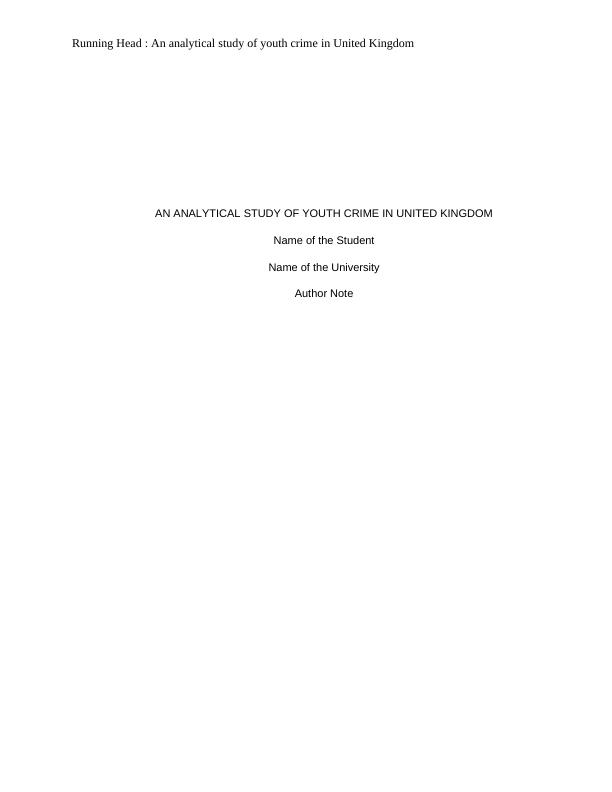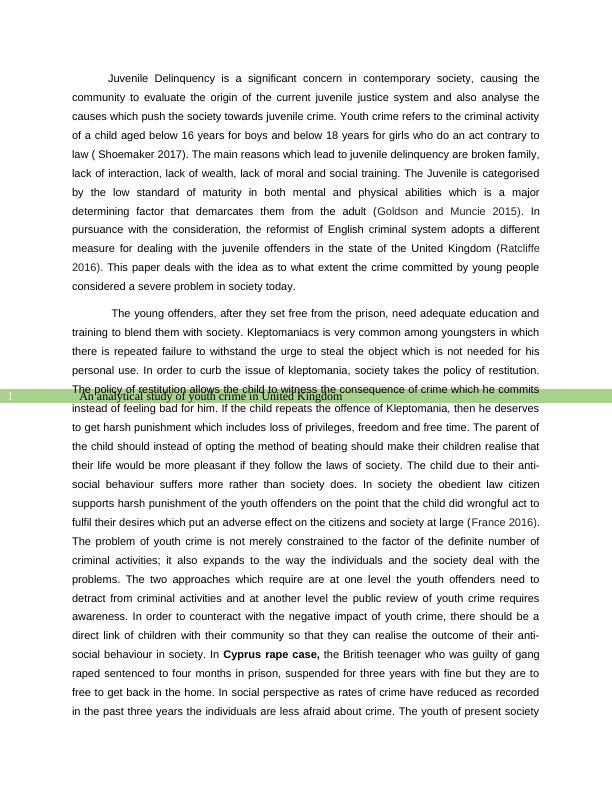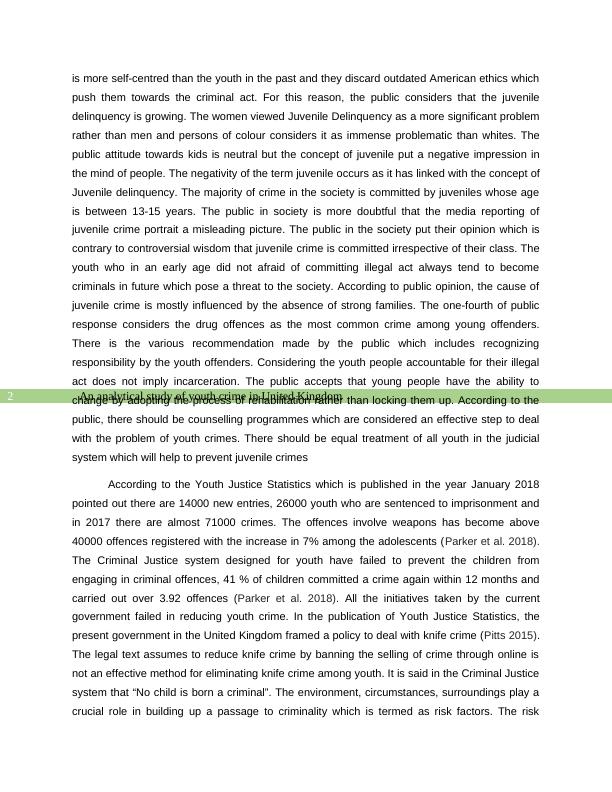An Analytical Study of Youth Crime in United Kingdom
Added on 2022-08-30
6 Pages2339 Words25 Views
Running Head : An analytical study of youth crime in United Kingdom
AN ANALYTICAL STUDY OF YOUTH CRIME IN UNITED KINGDOM
Name of the Student
Name of the University
Author Note
AN ANALYTICAL STUDY OF YOUTH CRIME IN UNITED KINGDOM
Name of the Student
Name of the University
Author Note

An analytical study of youth crime in United Kingdom1
Juvenile Delinquency is a significant concern in contemporary society, causing the
community to evaluate the origin of the current juvenile justice system and also analyse the
causes which push the society towards juvenile crime. Youth crime refers to the criminal activity
of a child aged below 16 years for boys and below 18 years for girls who do an act contrary to
law ( Shoemaker 2017). The main reasons which lead to juvenile delinquency are broken family,
lack of interaction, lack of wealth, lack of moral and social training. The Juvenile is categorised
by the low standard of maturity in both mental and physical abilities which is a major
determining factor that demarcates them from the adult (Goldson and Muncie 2015). In
pursuance with the consideration, the reformist of English criminal system adopts a different
measure for dealing with the juvenile offenders in the state of the United Kingdom (Ratcliffe
2016). This paper deals with the idea as to what extent the crime committed by young people
considered a severe problem in society today.
The young offenders, after they set free from the prison, need adequate education and
training to blend them with society. Kleptomaniacs is very common among youngsters in which
there is repeated failure to withstand the urge to steal the object which is not needed for his
personal use. In order to curb the issue of kleptomania, society takes the policy of restitution.
The policy of restitution allows the child to witness the consequence of crime which he commits
instead of feeling bad for him. If the child repeats the offence of Kleptomania, then he deserves
to get harsh punishment which includes loss of privileges, freedom and free time. The parent of
the child should instead of opting the method of beating should make their children realise that
their life would be more pleasant if they follow the laws of society. The child due to their anti-
social behaviour suffers more rather than society does. In society the obedient law citizen
supports harsh punishment of the youth offenders on the point that the child did wrongful act to
fulfil their desires which put an adverse effect on the citizens and society at large (France 2016).
The problem of youth crime is not merely constrained to the factor of the definite number of
criminal activities; it also expands to the way the individuals and the society deal with the
problems. The two approaches which require are at one level the youth offenders need to
detract from criminal activities and at another level the public review of youth crime requires
awareness. In order to counteract with the negative impact of youth crime, there should be a
direct link of children with their community so that they can realise the outcome of their anti-
social behaviour in society. In Cyprus rape case, the British teenager who was guilty of gang
raped sentenced to four months in prison, suspended for three years with fine but they are to
free to get back in the home. In social perspective as rates of crime have reduced as recorded
in the past three years the individuals are less afraid about crime. The youth of present society
Juvenile Delinquency is a significant concern in contemporary society, causing the
community to evaluate the origin of the current juvenile justice system and also analyse the
causes which push the society towards juvenile crime. Youth crime refers to the criminal activity
of a child aged below 16 years for boys and below 18 years for girls who do an act contrary to
law ( Shoemaker 2017). The main reasons which lead to juvenile delinquency are broken family,
lack of interaction, lack of wealth, lack of moral and social training. The Juvenile is categorised
by the low standard of maturity in both mental and physical abilities which is a major
determining factor that demarcates them from the adult (Goldson and Muncie 2015). In
pursuance with the consideration, the reformist of English criminal system adopts a different
measure for dealing with the juvenile offenders in the state of the United Kingdom (Ratcliffe
2016). This paper deals with the idea as to what extent the crime committed by young people
considered a severe problem in society today.
The young offenders, after they set free from the prison, need adequate education and
training to blend them with society. Kleptomaniacs is very common among youngsters in which
there is repeated failure to withstand the urge to steal the object which is not needed for his
personal use. In order to curb the issue of kleptomania, society takes the policy of restitution.
The policy of restitution allows the child to witness the consequence of crime which he commits
instead of feeling bad for him. If the child repeats the offence of Kleptomania, then he deserves
to get harsh punishment which includes loss of privileges, freedom and free time. The parent of
the child should instead of opting the method of beating should make their children realise that
their life would be more pleasant if they follow the laws of society. The child due to their anti-
social behaviour suffers more rather than society does. In society the obedient law citizen
supports harsh punishment of the youth offenders on the point that the child did wrongful act to
fulfil their desires which put an adverse effect on the citizens and society at large (France 2016).
The problem of youth crime is not merely constrained to the factor of the definite number of
criminal activities; it also expands to the way the individuals and the society deal with the
problems. The two approaches which require are at one level the youth offenders need to
detract from criminal activities and at another level the public review of youth crime requires
awareness. In order to counteract with the negative impact of youth crime, there should be a
direct link of children with their community so that they can realise the outcome of their anti-
social behaviour in society. In Cyprus rape case, the British teenager who was guilty of gang
raped sentenced to four months in prison, suspended for three years with fine but they are to
free to get back in the home. In social perspective as rates of crime have reduced as recorded
in the past three years the individuals are less afraid about crime. The youth of present society

An analytical study of youth crime in United Kingdom2
is more self-centred than the youth in the past and they discard outdated American ethics which
push them towards the criminal act. For this reason, the public considers that the juvenile
delinquency is growing. The women viewed Juvenile Delinquency as a more significant problem
rather than men and persons of colour considers it as immense problematic than whites. The
public attitude towards kids is neutral but the concept of juvenile put a negative impression in
the mind of people. The negativity of the term juvenile occurs as it has linked with the concept of
Juvenile delinquency. The majority of crime in the society is committed by juveniles whose age
is between 13-15 years. The public in society is more doubtful that the media reporting of
juvenile crime portrait a misleading picture. The public in the society put their opinion which is
contrary to controversial wisdom that juvenile crime is committed irrespective of their class. The
youth who in an early age did not afraid of committing illegal act always tend to become
criminals in future which pose a threat to the society. According to public opinion, the cause of
juvenile crime is mostly influenced by the absence of strong families. The one-fourth of public
response considers the drug offences as the most common crime among young offenders.
There is the various recommendation made by the public which includes recognizing
responsibility by the youth offenders. Considering the youth people accountable for their illegal
act does not imply incarceration. The public accepts that young people have the ability to
change by adopting the process of rehabilitation rather than locking them up. According to the
public, there should be counselling programmes which are considered an effective step to deal
with the problem of youth crimes. There should be equal treatment of all youth in the judicial
system which will help to prevent juvenile crimes
According to the Youth Justice Statistics which is published in the year January 2018
pointed out there are 14000 new entries, 26000 youth who are sentenced to imprisonment and
in 2017 there are almost 71000 crimes. The offences involve weapons has become above
40000 offences registered with the increase in 7% among the adolescents (Parker et al. 2018).
The Criminal Justice system designed for youth have failed to prevent the children from
engaging in criminal offences, 41 % of children committed a crime again within 12 months and
carried out over 3.92 offences (Parker et al. 2018). All the initiatives taken by the current
government failed in reducing youth crime. In the publication of Youth Justice Statistics, the
present government in the United Kingdom framed a policy to deal with knife crime (Pitts 2015).
The legal text assumes to reduce knife crime by banning the selling of crime through online is
not an effective method for eliminating knife crime among youth. It is said in the Criminal Justice
system that “No child is born a criminal”. The environment, circumstances, surroundings play a
crucial role in building up a passage to criminality which is termed as risk factors. The risk
is more self-centred than the youth in the past and they discard outdated American ethics which
push them towards the criminal act. For this reason, the public considers that the juvenile
delinquency is growing. The women viewed Juvenile Delinquency as a more significant problem
rather than men and persons of colour considers it as immense problematic than whites. The
public attitude towards kids is neutral but the concept of juvenile put a negative impression in
the mind of people. The negativity of the term juvenile occurs as it has linked with the concept of
Juvenile delinquency. The majority of crime in the society is committed by juveniles whose age
is between 13-15 years. The public in society is more doubtful that the media reporting of
juvenile crime portrait a misleading picture. The public in the society put their opinion which is
contrary to controversial wisdom that juvenile crime is committed irrespective of their class. The
youth who in an early age did not afraid of committing illegal act always tend to become
criminals in future which pose a threat to the society. According to public opinion, the cause of
juvenile crime is mostly influenced by the absence of strong families. The one-fourth of public
response considers the drug offences as the most common crime among young offenders.
There is the various recommendation made by the public which includes recognizing
responsibility by the youth offenders. Considering the youth people accountable for their illegal
act does not imply incarceration. The public accepts that young people have the ability to
change by adopting the process of rehabilitation rather than locking them up. According to the
public, there should be counselling programmes which are considered an effective step to deal
with the problem of youth crimes. There should be equal treatment of all youth in the judicial
system which will help to prevent juvenile crimes
According to the Youth Justice Statistics which is published in the year January 2018
pointed out there are 14000 new entries, 26000 youth who are sentenced to imprisonment and
in 2017 there are almost 71000 crimes. The offences involve weapons has become above
40000 offences registered with the increase in 7% among the adolescents (Parker et al. 2018).
The Criminal Justice system designed for youth have failed to prevent the children from
engaging in criminal offences, 41 % of children committed a crime again within 12 months and
carried out over 3.92 offences (Parker et al. 2018). All the initiatives taken by the current
government failed in reducing youth crime. In the publication of Youth Justice Statistics, the
present government in the United Kingdom framed a policy to deal with knife crime (Pitts 2015).
The legal text assumes to reduce knife crime by banning the selling of crime through online is
not an effective method for eliminating knife crime among youth. It is said in the Criminal Justice
system that “No child is born a criminal”. The environment, circumstances, surroundings play a
crucial role in building up a passage to criminality which is termed as risk factors. The risk

End of preview
Want to access all the pages? Upload your documents or become a member.
Related Documents
Surname2. Student’s Name. Professor’s Name. Class. Datelg...
|3
|478
|802
Raise the Age - A reform for Juvenile Justicelg...
|4
|733
|33
Evaluation Of Youth Justicelg...
|10
|2262
|53
Research Paper on Increasing Youth Crime in Australialg...
|9
|2287
|257
Should Juvenile Offenders be Tried and Punished in a Court of Law?lg...
|10
|2288
|248
Scare them straight: Juvenile Delinquency should be dealt with quickly and harshlylg...
|9
|2917
|333
